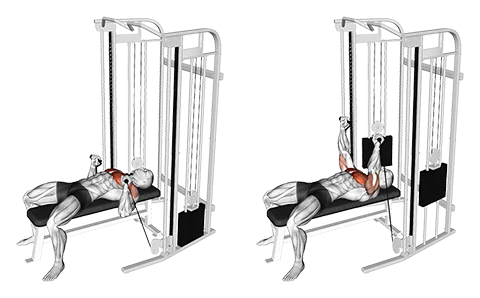Introduction
The cable bench press is a resistance training exercise that utilizes a pulley system and adjustable cables to strengthen the chest muscles. It primarily targets the pectoralis major and minor, as well as the deltoids and triceps. The exercise is effective for building upper body strength and definition, making it an ideal choice for individuals aiming to improve their push-up performance or attain a more toned physique. Its versatility allows users to adjust resistance levels easily, making it suitable for various fitness goals and abilities.
Muscles Worked
- Primary: Chest (Pectoralis Major)
- Secondary: Shoulders (Deltoids), Triceps (Triceps Brachii), and Core (Rectus Abdominis, Obliques)
How to Do It (Step-by-Step)
- Set up a cable machine by attaching handles to high pulleys and standing facing the equipment with a shoulder-width stance. Grab the handles at chest level with an overhand grip.
- Bend your elbows slightly as you lean forward, keeping your back straight. This is the starting position.
- Press the handles upwards in a controlled motion, contracting your chest muscles until your arms are fully extended. Pause briefly and then slowly lower the handles back to the starting position, keeping tension on the cables throughout the movement.
- Tip: To avoid injury, make sure you're not bouncing or jerking the weights during the exercise and maintain proper form throughout each repetition.
Rep & Rest Guidelines
- Strength: 4–6 reps, 2–3 min rest
- Hypertrophy: 8–12 reps, 60–90 sec rest
- Endurance: 12–20 reps, 30–60 sec rest
Using Volym's Auto Progression for optimal gains Auto Progression and Rest Timer to optimize your breaks between sets Rest Timer.
Form Tips
- Maintain a tight grip on the barbell to ensure control and stability throughout the movement.
- Keep your back flat against the bench, avoiding excessive arching or rounding. This helps prevent injuries and maximizes muscle activation.
- Lower the bar slowly and controlled, bringing it just above the nipple line before pushing it back up. Avoid letting the bar touch your chest or bouncing it off to reduce stress on the shoulders and joints.
When to Use It
- Developing upper chest strength for swimmers and triathletes
- Building balanced pecs for weightlifters preparing for a bench press competition
- Enhancing overall chest muscle definition in bodybuilding routines
Stay on track with your workout history: Workout History
The cable bench press primarily works the pectoralis major, deltoids, and triceps.
Cables provide constant tension throughout the range of motion, enhancing muscle growth and strength.
Attach handles or ropes to adjustable pulleys for performing cable bench presses.
Perform 3-4 sets of 8-12 repetitions, adjusting the weight based on your fitness level and goals.
You can use either a flat or inclined bench, depending on your preference and target muscle focus.

